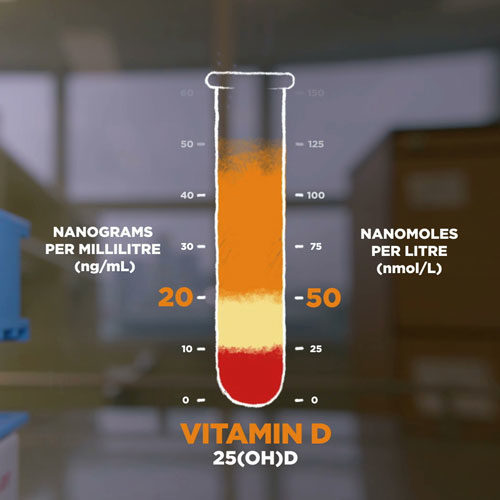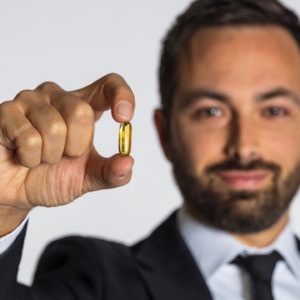Unlike most other vitamins, our body can make it’s own vitamin D when skin is exposed to sunlight or UV-B rays. Our body then converts the vitamin D into a hormone often referred to as activated vitamin D or calcitriol.
Vitamin D is important for strong and healthy bones. It helps to absorb the calcium and phosphorous needed to develop bone structure and maintain strength.
Vitamin D is not found in many foods. Fatty fish like cod, salmon, mackerel and sardines are among the best food sources of vitamin D and small amounts are found in milk and butter.
Instead our body usually makes vitamin D from sunlight, rather than extracting it from food like most other vitamins, which makes knowing whether we are getting the right amount more complex.
When there is sufficient UV radiation (UVI 3 or greater) most people obtain sufficient vitamin D going about their everyday activities. However, when the UVI is low more deliberate sun exposure to a greater surface area of the body is needed to generate sufficient vitamin D. There are some parts of the world where there is not enough UV radiation in winter to generate vitamin D. Supplementation may be required in this situation.
When out in the sun for more than a few minutes, always wear protective clothing and apply sunscreen.
If we don’t have enough vitamin D we are at risk of developing crippling diseases like rickets (in children) and osteomalacia (in adults) that cause bones to weaken.
If we have too much, we develop vitamin D toxicity, a serious condition that can lead to hypercalcaemia.
How MUCH VITAMIN D DO WE NEED?
If appropriate, doctors can test the levels of Vitamin D (or 25(OH)D), in the blood.
When receiving results, knowing which unit of measurement, ng/mL or nmol/L, the blood levels have been measured in is important.
In most countries, vitamin D levels are measured using units called nanomoles per litre or nmol/L.
In the US and a handful of other countries, levels are measured using nanograms per millilitre or ng/mL.
The two differing units of measurement are much like metric vs imperial and this can lead to confusion about the results.
To convert ng/ml to nmol/L multiply the ng/ml by 2.5 for example 50 ng/ml is equivalent to 125 nmol/L.
L.

Even though, there is still debate about how much we actually need, most experts agree that below 25 nmol/L (or 10 ng/ml) is considered deficient.
Levels this low are associated with bone diseases like rickets or osteomalacia.
But the jury’s out on what is agreed to be a healthy level.
Some experts argue 25-30 nmol/L in the blood is sufficient, some say over 50 nmol/L is optimal for good bone health for most people, while others again advocate for 75 nmol/L or even higher.
Excess or toxic levels of vitamin D are thought be over 250 nmol/L (100 ng/ml), but again there are many views on this. Vitamin D or 25(OH)D concentration can be very high before hypercaelcemia occurs. Several studies suggest it is safe to have a 25(OH)D concentration of 300 nmol/L (120ng/ml).
And of course our optimal vitamin D levels are influenced by our age, gender, weight and health.
It’s a complex area, we highly recommend seeing a health care professional to assist with understanding your vitamin D levels.
If you are interested in finding out more about vitamin D, vitamin D testing or the current research into vitamin D and our health, here a few links from trusted sources to help get you started.
Further reading
Vitamin D
https://www.betterhealth.vic.gov.au/health/healthyliving/vitamin-d
https://ods.od.nih.gov/factsheets/VitaminD-Consumer/
Vitamin D Testing
https://www.healthdirect.gov.au/vitamin-d-test
https://www.labtestsonline.org.au/learning/test-index/vitamin-d
http://www.vitamindservice.com/node/91
Vitamin D levels
https://www.cancer.org.au/preventing-cancer/sun-protection/vitamin-d/
https://www.nutrition.org.uk/healthyliving/helpingyoueatwell/vitamind.html
https://www.healthdirect.gov.au/vitamin-d-deficiency
https://www.rcpa.edu.au/Library/Practising-Pathology/RCPA-Manual/Items/Pathology-Tests/V/Vitamin-D
https://www.health.harvard.edu/blog/vitamin-d-testing-recommended-people-201411267547
https://www.vox.com/science-and-health/2017/6/20/15838152/vitamin-d-deficiency-foods-symptoms
https://www.nejm.org/doi/full/10.1056/NEJMra070553
Vitamin D Research


